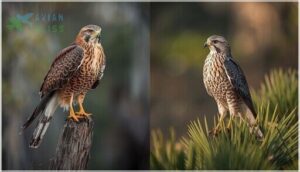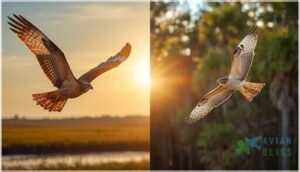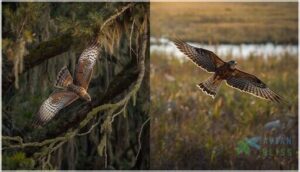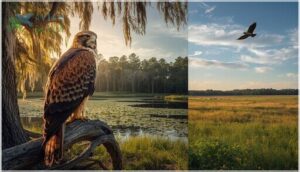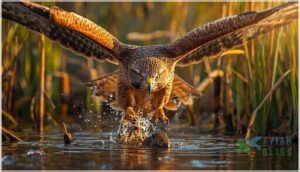This site is supported by our readers. We may earn a commission, at no cost to you, if you purchase through links.
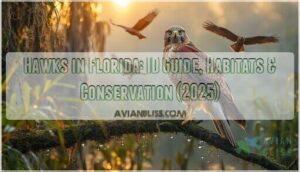
Each species brings unique hunting styles, habitat preferences, and identification challenges that separate casual observers from confident birders.
Understanding which hawks call Florida home year-round, which arrive only in winter, and how to distinguish a Buteo’s broad wings from an Accipiter’s quick bursts helps you decode the aerial drama unfolding overhead.
Table Of Contents
- Key Takeaways
- Common Hawk Species in Florida
- How to Identify Hawks in Florida
- Hawk Habitats and Distribution
- Hawk Diet and Hunting Behavior
- Conservation Status and Population Trends
- Frequently Asked Questions (FAQs)
- What’s the most common hawk in Florida?
- What attracts hawks to your yard?
- Why are hawks around my house?
- Are hawks good to have around?
- How do hawks avoid predators in Florida?
- What time of year do hawks migrate?
- How can I identify a juvenile hawk?
- Do hawks pose a threat to pets?
- What sounds do hawks make in Florida?
- Can hawks be kept as pets in Florida?
- Conclusion
Key Takeaways
- You’ll find five year-round hawk residents in Florida—Red-shouldered, Red-tailed, Cooper’s, and the rare Short-tailed Hawks—while Sharp-shinned Hawks and Northern Harriers only visit during winter months from September through April.
- Identifying hawks comes down to wing shape: Buteos like Red-tailed Hawks have broad wings for soaring over open areas, while Accipiters like Cooper’s Hawks sport rounded wings and long tails for quick turns through forests.
- Hawks have adapted their diets to Florida’s landscape, with Red-shouldered Hawks eating mostly reptiles and amphibians in wetlands, Red-tailed Hawks focusing on mammals, and Cooper’s Hawks specializing in catching birds near backyard feeders.
- Florida’s hawk populations show mixed trends—Red-tailed Hawks have increased tenfold since the 1950s, but habitat loss, rodenticide poisoning, and vehicle collisions threaten other species, making citizen science tracking through programs like eBird essential for conservation.
Common Hawk Species in Florida
Florida is home to several hawk species, each with unique traits that make them easier to spot once you know what to look for. Some live here year-round, while others pass through during migration or spend their winters in the state.
Let’s look at the most common hawks you’re likely to see and what sets them apart.
Red-Shouldered Hawk Identification and Range
Throughout Florida, you’ll find the Red-shouldered Hawk, a year-round resident with distinctive plumage variations. Adult Florida subspecies (Buteo lineatus extimus) display pale, grayish heads and lighter barring compared to northern populations. Look for rusty shoulders, symmetrical black-and-white wing bands, and listen for their sharp “kee-yeeear” vocalizations.
Southern Florida populations show considerable genetic distinction and habitat adaptation, thriving from cypress swamps to suburban neighborhoods statewide. These hawks often hunt by perch hunting tactics to locate prey.
Red-Tailed Hawk Features and Habitats
You’ll recognize the Red-tailed Hawk (Buteo jamaicensis) by its broad, rounded wings and namesake reddish tail. Florida subspecies (B. j. umbrinus) show darker backs with plumage variation, staying year-round in open woodlands, grasslands, and agricultural areas. Their dietary adaptations include mammals, reptiles, and birds.
Since the 1950s, population growth has soared tenfold. These hawks prefer nesting in tall trees at woodland edges, demonstrating striking hawk physical characteristics across diverse hawk habitats statewide. The incubation period lasts approximately 28-35 days.
Cooper’s Hawk Year-Round Presence
Unlike other hawk species that shift with the seasons, you’ll find Cooper’s Hawks (Accipiter cooperii) hunting Florida’s woodlands and neighborhoods every month of the year. Breeding confirmed as far south as Highlands County, these agile raptors maintain habitat stability statewide—resident birds stay put while northern migrants boost winter numbers.
Key aspects of Cooper’s Hawk year-round presence:
- Urban adaptations enable hunting in suburban parks, backyards, and city landscapes
- Breeding success yields 2-4 fledglings per nest during April-May nesting season
- Dietary variations shift between birds (40-54% biomass) and small mammals seasonally
- Migration patterns differ from northern populations—Florida birds remain sedentary
- Habitat stability maintained since 1930s, with increased southern Florida nesting frequency
Sharp-Shinned Hawk Seasonal Visits
While Cooper’s Hawks stick around all year, you’ll spot the smaller Sharp-shinned Hawk (Accipiter striatus) only during its seasonal presence from September through April. Migration routes funnel roughly 2,800 individuals through Florida each fall, with peak hawk sighting frequency hitting in October.
Winter habitats include forests and suburban feeders, where juveniles dominate the age distribution. Population counts confirm most depart by mid-April, heading north toward breeding grounds along established hawk migration patterns.
Northern Harrier Winter Occurrence
From late November through spring, you’ll find the Northern Harrier (Circus hudsonius) gliding low over Florida’s marshes and grasslands. Winter hawk sightings peak in southern regions, where habitat selection favors dense vegetation and prey availability.
Migration timing brings hundreds through the Keys each season, though population decline—driven by wetland loss—has reduced numbers. Watch for their distinctive hunting behavior: wings held in a shallow V, weaving methodically over fields.
Northern Harriers migrate through the Keys by the hundreds each season, but wetland loss has steadily reduced their numbers
Rare and Occasional Hawk Species
Occasionally, you’ll spot hawk species that barely register on Florida’s birding radar. These birds push the limits of hawk distribution in Florida, appearing as vagrants or migrants with unpredictable timing:
- Swainson’s Hawk: Rare fall migrant, mostly recorded through the Florida Keys during Swainson’s migration periods
- Zone-tailed Hawk: Accidental visitor; zone-tailed sightings remain exceptionally uncommon since the first 2000 record
- Short-tailed Hawk: Florida’s rarest breeding resident, with fewer than 500 individuals facing short-tailed threats from habitat loss
- Great Black Hawk: Exotic species with uncertain great black status; likely captive escapes rather than natural vagrants
How to Identify Hawks in Florida
Identifying hawks in Florida can feel tricky at first, but once you know what to look for, it gets much easier. Each species has its own set of clues, from the shape of its wings and tail to the colors and patterns on its feathers.
Let’s walk through the key features that’ll help you tell one hawk from another.
Key Physical Characteristics
You’ll notice hawks in Florida through distinct physical features that vary by species. Sexual dimorphism is evident—females consistently outweigh males by up to one-third.
Plumage variations help with identification: adults show richer colors while juvenile markings appear streakier and browner.
Size comparison matters too, as hawks range from the petite Sharp-shinned (3–8 ounces) to hefty Red-tails (24–46 ounces). Tail morphology and overall hawk morphology provide essential identification clues.
Wing and Tail Shape Differences
Wing and tail shapes are your best tools for hawk identification in Florida. Buteos like Red-tailed Hawks have broad wings (114–133 cm span) and short, wide tails for soaring over open areas. Accipiters such as Cooper’s Hawks show rounded wings and long tails (up to 29 cm) adapted for quick turns in forests.
These habitat adaptations directly influence flight aerodynamics and species distinctions.
Color Patterns and Markings
Color patterns separate Florida’s hawks more reliably than any other feature. Adult plumage differs dramatically from juvenile markings, so understanding these differences prevents misidentification. Here are three key identifiers to watch for:
- Red-tailed Hawks display brick-red tails in adults, while juveniles show brown barring
- Cooper’s Hawks have bluish-gray backs with pale orange barring below
- Red-shouldered Hawks feature distinctive checkered wings with rufous underparts
Regional variations and color morphs add complexity worth noting.
Size and Weight Variations
Hawks in Florida show dramatic size ranges even within the same species. Sexual dimorphism means females consistently outweigh males by 15–50%, with red-tailed hawks reaching up to 1,600 grams while sharp-shinned hawks barely hit 219 grams. Weight fluctuation throughout seasons, and size overlap between species complicates identification.
Length measurements span from 23 cm in sharp-shinned hawks to 65 cm in red-tails, though regional differences remain minimal across Florida hawk species.
Distinguishing Accipiters Vs. Buteos
Beyond size alone, you’ll find that wing shape and flight styles separate accipiters from buteos instantly. Accipiters fly with quick flaps and glides, weaving through forests on short, rounded wings and long tails with narrow dark bands. Buteos soar steadily over open Florida marshes, their broad wings and stubby tails making them unmistakable.
Habitat preference and hunting tactics mirror these differences perfectly.
Hawk Habitats and Distribution
Hawks in Florida don’t just show up anywhere—they’re drawn to specific landscapes that meet their hunting and nesting needs. From dense forests and quiet wetlands to open grasslands and even city parks, each species has its preferred territory.
Understanding where these birds live, and how they move throughout the year, will help you know exactly where to look.
Forests, Wetlands, and Woodlands
Throughout Florida’s dense forests and sprawling wetlands, you’ll find hawks that depend on these habitats for survival. Red-shouldered Hawks nest within 200 meters of permanent wetlands, where prey availability stays high. Short-tailed Hawks require mature cypress swamps for nesting, showing strong site fidelity.
Habitat loss threatens these forest dwellers, making conservation efforts critical. Wetland dependence shapes hawk habitat preferences, with nesting proximity to water influencing their behavior year-round.
Grasslands, Marshes, and Farmlands
Open grassland and marshes draw Northern Harriers during winter, while farmlands host Red-tailed Hawks year-round. You’ll spot Short-tailed Hawks hunting along marsh edges where prey abundance peaks.
Agricultural Impact shapes hawks in Florida, as Swainson’s Hawk nest success reaches 57% near cultivated fields. Habitat Fragmentation threatens these areas, making marsh restoration and conservation strategies essential for maintaining hawk habitat preferences across the state’s working landscapes.
Urban and Suburban Sightings
You might spot Red-shouldered and Cooper’s Hawks right in your neighborhood—they’ve adapted to suburban distribution across Florida’s metro areas. Urban nesting happens in mature trees near golf courses and parks, where prey availability stays high. Behavioral adaptations include using light poles and billboards for nests.
During breeding season, human interactions intensify as protective hawks defend territories, sometimes swooping at perceived threats near their nests.
Seasonal Migration Patterns
From September through November, you’ll witness Florida’s peak migration as thousands of hawks funnel through the state. Weather influence, especially cold fronts in October, triggers massive movements along the Gulf Coast and Florida Keys—key stopover sites where juvenile migration dominates.
- Fall migration spans September to November, peaking in October
- Spring passage occurs February through May
- Broad-winged Hawks form 90% of migrant buteos
- Barrier islands see up to 1,500 hawks daily
- Seasonal presence shifts as northern breeders move south
Hawk Diet and Hunting Behavior
Hawks in Florida have adapted to hunt a wide variety of prey, from small songbirds to mammals and reptiles. Each species uses distinct hunting techniques based on their physical build and preferred habitat.
Understanding what hawks eat and how they capture their food helps you appreciate these skilled predators in action.
Primary Prey and Food Sources
Hawks in Florida adapt their diets to what’s available, with prey size, habitat influence, and seasonal variation shaping their food sources. Here’s what you need to know about hawk diets and prey:
| Hawk Species | Primary Prey (% of Diet) |
|---|---|
| Red-shouldered | Reptiles (58%), amphibians (18%), mammals (16%) |
| Red-tailed | Mammals (85%), birds (<15%), reptiles |
| Cooper’s | Birds (88-98%), small mammals (10-18%) |
| Sharp-shinned | Songbirds (90%), rodents/insects (<10%) |
| Northern Harrier | Small mammals, birds (hearing-dependent) |
Prey size varies considerably. Red-tailed Hawks consume items from 10 to 1,000 grams daily, while Sharp-shinned males focus on warblers under 40 grams. Cooper’s Hawks can take up to 700 birds annually in high-density areas.
Seasonal variation is most evident in Red-shouldered Hawks, which increase amphibian and reptile consumption during Florida’s wet seasons. In wetland habitats, these shifts are dramatic compared to drier uplands where mammals dominate.
Habitat influence extends beyond moisture. Urban Cooper’s Hawks exploit backyard feeders, while invasive species and localized extinctions directly impact hunting success. Florida’s diverse landscape—from marshes to suburbs—creates a mosaic where hawks adjust their food sources opportunistically, ensuring survival across changing conditions.
Hunting Strategies and Techniques
You’ll find that perch hunting dominates hawk behavior in Florida, with Red-shouldered Hawks relying on it for 67% of their prey captures. Ambush tactics give Sharp-shinned and Cooper’s Hawks success rates above 30% near feeders, while aerial pursuit through stooping boosts capture odds to 47%.
Success rates vary by habitat influence—dense forests favor surprise attacks, open grasslands prompt soaring strategies, and raptor hunting techniques shift with predatory birds adapting to seasonal prey availability.
Adaptations for Prey Capture
Your chances of spotting successful raptor hunting techniques improve when you understand the sharp tools hawks in Florida bring to every chase. Talon morphology delivers crushing force up to 200 psi, while visual acuity lets them detect prey beyond 100 meters.
Consider these hawk behavior and hunting advantages:
- Talons curve at 120 degrees for instant grip
- Flight speed hits 40-60 km/h during strikes
- Capture timing sharpens after 300 practice attempts
- Dietary specialization drives beak adaptations for tearing flesh
Hawk diet and prey choices depend on these built-in weapons.
Seasonal Shifts in Diet
Prey availability in Florida’s wetlands shifts dramatically with rainfall, and you’ll notice red-shouldered hawks adapt by consuming 30% amphibians during wet months but over 50% mammals in winter. Dietary adaptations respond to wetland flooding, when crayfish emerge.
Sharp-shinned hawks maintain 90% songbird diets year-round, though winter predation intensifies near feeders.
Juveniles exploit invasive species like brown anoles, comprising 15-20% of summer hawk food sources.
Conservation Status and Population Trends
Hawks in Florida are protected by law, but they still face real challenges in the wild. Understanding their legal status, the threats they encounter, and how their populations are changing helps you see the bigger picture of hawk conservation.
Let’s look at what’s being done to protect these birds and how you can contribute to tracking their numbers.
Legal Protections in Florida
You can’t just admire Florida’s hawks from afar—these raptors are fully protected under both federal and state law. Every native hawk species falls under the Migratory Bird Treaty Act and FWC regulations, which means:
- Capturing or killing hawks without permits results in MBTA violations carrying fines up to $15,000
- Active nest removal requires federal authorization
- Falconry permits demand rigorous testing and facility approval
- Penalty standards include equipment forfeiture and potential felony charges
This conservation framework safeguards vulnerable species across Florida’s diverse wildlife habitats.
Threats to Hawk Populations
Despite legal protections, hawks in Florida face serious threats to their survival. Habitat fragmentation and urban sprawl have eliminated over 27% of mature forest since 1980, limiting nesting sites for vulnerable species.
Rodenticide poisoning causes neurological damage in Red-shouldered Hawks, while vehicle collisions represent growing mortality factors—Cooper’s Hawk strikes increased 3200% since 1990.
Climate impacts, particularly sea level rise, threaten critical wintering grounds. Illegal nest disturbances and intentional killings persist despite wildlife conservation laws.
Hawk Population Trends and Citizen Science
Monitoring initiatives like the Florida Keys Raptor Migration Project reveal mixed hawk population trends—Red-tailed Hawks increased tenfold since the 1950s, while some migratory species show annual declines of 2.6% to 12.8%.
Over 1,400 volunteers now track 350+ nests statewide, contributing thousands of observation hours. These volunteer contributions power platforms like eBird, directly shaping conservation strategies for hawks in Florida’s changing landscape.
Frequently Asked Questions (FAQs)
What’s the most common hawk in Florida?
You’ll spot the Red-shouldered Hawk most often in Florida year-round. With nearly 9 million birds across the U.S., they thrive in wetlands and forests, making identification easier than other hawks in Florida.
What attracts hawks to your yard?
You mightn’t roll out the red carpet, but hawks notice what you don’t: prey abundance, perch availability, water access, nesting sites, and habitat structure all draw these raptors to your Florida yard naturally.
Why are hawks around my house?
Hawks are around your house because suburban Florida offers abundant prey like rodents and small birds, plus tall trees for perching and nesting. Your yard provides ideal hunting grounds and shelter.
Are hawks good to have around?
Think of them as nature’s balancing act—raptors that keep pests in check and support ecosystem balance.
Their presence boosts bird diversity, offers a natural solution to rodent problems, and helps maintain property value and ecosystem health.
How do hawks avoid predators in Florida?
You’ll notice their sharp eyesight spots threats over a mile away. They rely on camouflage techniques, vigilance behaviors, and mobbing defense.
Aerial displays and aggressive nest protection further guarantee survival against predators.
What time of year do hawks migrate?
In Florida, migration patterns shift with the seasons. Peak migration unfolds during spring, mid-April to mid-May, and fall, September through mid-November.
Cold fronts, wind influence, prey abundance, and day length drive the seasonal presence of hawks.
How can I identify a juvenile hawk?
You can identify juvenile hawks by examining plumage differences, eye color, and structural changes. Look for streaked underparts, pale yellow eyes, and longer wing shapes. Body proportions and tail patterns help distinguish immature birds from adults.
Do hawks pose a threat to pets?
Yes, hawks can pose a threat to small pets under five pounds, especially those left unsupervised outdoors. Pet size vulnerability and predation risk factors increase near nesting sites, but responsible pet ownership and mitigation strategies greatly reduce hawk attack frequency.
What sounds do hawks make in Florida?
You’ll hear the Red-shouldered Hawk’s loud “kee-aah” call most often in Florida. Red-tailed Hawks produce a hoarse, screaming vocalization, while Cooper’s Hawks emit a grating “cak-cak-cak” during breeding season.
Can hawks be kept as pets in Florida?
All raptors are protected by federal and state laws in Florida, making pet ownership illegal without proper permits.
Falconry requires licensing, exams, and sponsorship—strictly regulated to protect birds of prey.
Conclusion
Spotting hawks in Florida becomes second nature once you learn their silhouettes and calls. Each sighting sharpens your eye, turning highway drives and backyard moments into chances to witness these raptors’ hunting prowess.
Whether you’re tracking a Red-shouldered Hawk’s territorial cry or watching a Northern Harrier quarter winter fields, you’re connecting with species shaped by millions of years of predatory refinement.
Keep binoculars handy, report your observations, and you’ll contribute to conservation efforts protecting Florida’s aerial predators.
- https://opticsmag.com/hawk-species-in-florida/
- https://www.audubon.org/field-guide/bird/short-tailed-hawk
- https://sora.unm.edu/sites/default/files/FFN_15-2p45-51Kiltie%5B1%5D.pdf
- https://myfwc.com/license/wildlife/protected-wildlife-permits/raptors/
- https://www.allaboutbirds.org/guide/Short-tailed_Hawk/overview

